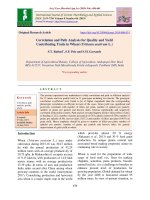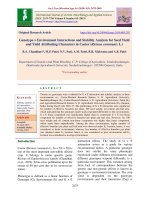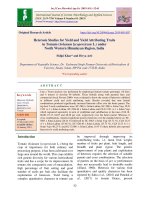Genotype × environment interactions and stability analysis for seed yield and yield attributing characters in castor (Ricinus communis L.)
Bạn đang xem bản rút gọn của tài liệu. Xem và tải ngay bản đầy đủ của tài liệu tại đây (40 KB, 7 trang )
Int.J.Curr.Microbiol.App.Sci (2019) 8(5): 2475-2481
International Journal of Current Microbiology and Applied Sciences
ISSN: 2319-7706 Volume 8 Number 05 (2019)
Journal homepage:
Original Research Article
/>
Genotype × Environment Interactions and Stability Analysis for Seed Yield
and Yield Attributing Characters in Castor (Ricinus communis L.)
B.A. Chaudhari*, M.P. Patel, N.V. Soni, A.M. Patel, R.R. Makwana and A.B. Patel
Department of Genetics and Plant Breeding, C. P. College of Agriculture, Sardarkrushinagar,
Dantiwada Agricultural University, Sardarkrushinagar– 385506 (Gujarat), India
*Corresponding author
ABSTRACT
Keywords
Stability analysis, G
x E interaction,
Grain yield, Castor
genotype, Over
environments
Article Info
Accepted:
26 April 2019
Available Online:
10 May 2019
Twenty six genotypes were evaluated for G × E interaction and stability analysis in three
environments viz., Castor-Mustard Research Station, S. D. Agricultural University,
Sardarkrushinagar (E1), Cotton Research Station, S. D. Agricultural University, Talod (E 2)
and Agricultural Research Station, S. D. Agricultural University, Kholwada (E 3) (Gujarat,
India) during kharif-rabi 2016-17. The partitioning of G × E interaction were significant
for number of effective branches per plant, 100 seed weight, oil content and leaf area,
which indicated that the genotypes under study responded differently to the environments.
G × E linear component was significantly higher than its counterpart G × E non-linear
component for number of effective branches per plant and leaf area. However, for 100
seed weight and oil content non-linear component was higher than linear component,
which made them unpredictable. Among the three environments, higher number of
effective branches per plant and leaf area was observed under E 1 location, hence, it was
considered as better environment; whereas, less number of effective branches per plant
was obtained under E3 location, hence, it was considered as poor environment and E 2
location was considered as average environment.
Introduction
Castor (Ricinus communis L. 2n = 2X = 20) is
one of the most important non-edible oilseed
crop. It belongs to mono specific genus
Ricinus of Euphorbiaceae family (Chaudhari
et al., 2019). It has cross pollination up to the
extent of 50 per cent due to its monoecious
nature.
Phenotype is defined as a linear function of
Genotype (G), Environment (E) and G × E
interaction effects. The study of G × E
interaction serves as a guide for various
environmental niches. A particular genotype
does not exhibit the same phenotypic
expression under different environments and
different genotypes respond differently to a
particular environment. This variation arising
from lack of correspondence between the
genetic and non-genetic effects is known as
genotype × environment interaction. The crop
yield is dependent on the genotype,
environments and their interaction (Pagi et
2475
Int.J.Curr.Microbiol.App.Sci (2019) 8(5): 2475-2481
al., 2017a,b). When interaction between
genotype and environment is present, ranking
of genotype will be different under different
environments. The plant breeder always
interested in the stability of the performance
for the characters which are of economically
important. The desirable hybrid should have
low genotype × environment interaction for
important characters, so as to get desirable
performance of hybrids over wild range of
environmental conditions. Such hybrids are
said to be stable because for their stable
performance under changing environments.
The presence of G × E interaction is a major
problem in getting a reliable estimate of
heritability, difficult to predict with a greater
accuracy rate of the genetic progress under
selection for a given character. Hence, the
knowledge of magnitude and nature of G × E
interaction is very useful to plant breeders.
The statistical techniques to measure the G ×
E interaction developed by Finlay and
Wilkinson (1963), Eberhart and Russell
(1966) and Perkins and Jinks (1968) have
been very useful in breeding programmes. In
the present investigation, the approach of
Eberhart and Russell (1966) was used to
understand the G × E interaction and stability
of different genotypes.
Materials and Methods
Twenty six genotypes of castor were selected
for study. The field experiment was
conducted at three different location viz.,
Castor-Mustard Research Station, S. D.
Agricultural University, Sardarkrushinagar
(E1), Cotton Research Station, S. D.
Agricultural University, Talod (E2) and
Agricultural Research Station, S. D.
Agricultural University, Kholwada (E3)
during kharif-rabi 2016-17 with spacing of
120 cm Χ 60 cm, in RBD with three
replications. Standard agronomic practices
were followed to raise the crop. The various
quantitative traits viz., Days to flowering
(primary raceme), Days to maturity (primary
raceme), Number of nodes up to the primary
raceme, Effective length of primary raceme
(cm), Plant height up to primary raceme (cm),
Seed yield per plant (g), 100 seed weight (g),
Number of capsules on primary raceme, Leaf
area (cm2) and Oil content (%) were included
for study. Analysis of variance was performed
and stability parameters were conducted
following the model proposed by Eberhart
and Russell (1966). The type of stability was
decided on regression coefficient (bi) and
mean values (Finaly and Wilkinson, 1963).
Results and Discussion
The mean sum of squares due to genotypes
was highly significant for all the 11
quantitative characters studied across the
environments, which indicated the presence
of substantial amount of variation in the
material studied. The analysis also indicated
significant variation among the environments
for all the characters. The values of G × E
interaction were significant for number of
effective branches per plant, 100 seed weight,
oil content and leaf area (Table 1), which
indicated that genotypes interacted differently
with environmental variations for the said
characters. Highly significant values of mean
square due to environments (linear) for all the
characters indicated that environments
differed considerably among different
locations. The mean square values due to G ×
E (linear) and G × E (pooled deviation) were
found to be significant for number of effective
branches per plant, 100 seed weight, oil
content and leaf area.
The stability parameters were worked out and
interpreted only for the characters which had
significant values of G × E mean square and
greater magnitude of G × E (linear)
component in respect to pooled deviation i.e.
G × E (non-linear), thereby only two
2476
Int.J.Curr.Microbiol.App.Sci (2019) 8(5): 2475-2481
characters number of effective branches per
plant and leaf area were considered for
estimation of stability parameters. While, for
100 seed weight and oil content non-linear
component (pooled deviation) was higher
than linear component, which made
genotypes unpredictable and prediction would
be biased or less reliable. The stability
parameters employed for identification of
stable genotype were high or low mean value
than population mean, a regression coefficient
(bi) equals to unity and a mean square
deviation
from
regression
coefficient
statistically equal to zero (S2di).
The higher number of effective branches per
plant is desirable for higher seed yield. The
results revealed that total 19 genotypes had
non significant deviation from regression
coefficient and 10 genotypes had higher
number of effective branches per plant than
mean, out of these, 18 genotypes were
identified (bi> 1 and significant: nine and bi<
1 and significant: nine) as well adapted to
different
environments.
Among
the
genotypes, nine genotypes GCH-2, GCH-7,
SHB-1005, SHB-1019, SHB-1029, GNCH-1,
GEETA, 48-1 and JI-96 had below average
stability (Mean > genotypes mean; bi> 1 and
S2di = 0 NS), thereby specifically adapted to
favorable environment; while, nine genotypes
GAUCH-1, GCH-4, SHB-1018, VP-1, SKI352, SKI-370, SKI-372, SKI-373 and DCS-94
had above average stability (Mean >
genotypes mean; bi< 1 and S2di = 0 NS),
hence specifically adapted to poor
environment (Table 2). Higher leaf area is
desirable for higher seed yield. The results
revealed that total 22 genotypes had nonsignificant
deviation
from
regression
coefficient and 10 genotypes had higher leaf
area than mean. Out of 26 genotypes, nine
genotypes were identified (bi> 1 and
significant: seven and bi< 1 and significant:
two) as well adapted to different
environments. Among the genotypes, two
genotypes GCH-6 and JP-65 had below
average stability (Mean > genotypes mean;
bi> 1 and S2di = 0 NS), thereby specifically
adapted to favorable environment; while,
genotypes GCH-4 had above average stability
(Mean > genotypes mean; bi< 1 and S2di = 0
NS), hence specifically adapted to poor
environment (Table 2).
The results partially confirmed the findings of
Henry and Daulay (1985), Tank (2000), Patel
(2001), Thakker (2002), Solanki and Joshi
(2003), Kumari et al.,(2003), Chaudhari
(2006), Patel and Pathak (2006), Sasidharan
(2005), Patel et al., (2010), Patel et al.,(2011),
Dhedhi et al., (2012) and Patel et al., (2015).
However, among the characters under
consideration, five characters had higher
magnitude of non-linear component (pooled
deviation) than its counterpart linear
component of G × E interaction; thereby it
would not be possible to predict the
performance of genotypes for different
environments. Further, the significant G × E
(linear) component for those characters
indicated that the regression coefficients were
statically differed and the variation in the
performance of genotypes was due to
environment induced in genotypes and hence
performance of genotypes would be
predictable. The results are in agreement with
the findings of Henry and Daulay (1985),
Thakker (2002), Solanki and Joshi (2003),
Chaudhari (2006), Patel and Pathak (2006),
Sasidharan (2005) and Patel (2009), Thakker
et al., (2010) and Patel (2010). However,
pooled deviation variances were significant
for number of effective branches per plant,
100 seed weight, oil content and leaf area.
The results are also in partial agreement with
reports of Patel et al., (1984), Patel (2001),
Thakker (2002),Solanki and Joshi (2003),
Patel and Pathak (2006), Sasidharan (2005),
Patel (2009), Thakker et al., (2010) and Patel
(2010).
2477
Int.J.Curr.Microbiol.App.Sci (2019) 8(5): 2475-2481
Table.1 Analysis of variance for phenotypic stability for different characters
Source of
variation
d.f.
25
Genotypes
2
Environments
50
GxE
52
Env.+
(Gen. x Env.)
1
Environments
(Lin.)
25
G x E (Lin.)
26
Pooled
Deviation
Pooled Error 150
Days to
Days to Number
flowering maturity of nodes
(primary (primary
up to
raceme) raceme) primary
raceme
Seed
yield per
plant (g)
88.81**
9.16*
1.13
1.44*
123.20**
11.34**
3.58
3.88
14.43**
3.44**
0.43
0.55
Effective Number Number
100
Oil
Plant
length of
of
of
seed
content
height
primary capsules effective weight
(%)
up to
raceme
in
branches
primary
primary
per
raceme
raceme
plant
(cm)
8868.08** 239.95** 947.97** 14.01** 15.83** 3600.70** 10.55**
3878.20** 92.57** 239.1**
13.91** 20.73** 406.11*
7.56**
54.48
1.67
11.89
0.24**
1.05**
46.85
0.63**
201.54**
5.17*
20.63
0.77**
1.81**
60.67
0.90**
18.31*
22.69**
6.87**
7756.39** 185.13**
0.68
1.52
3.52
3.51
0.42
0.43
56.68
50.27
0.97
6.39
0.70
248.33
Leaf area
(cm2)
51600913.77**
73942126.65**
4493594.59**
7164691.98**
478.2**
27.82**
41.45**
812.23**
15.13**
147884253.30**
1.54
1.73
11.98
11.36
0.26**
0.23**
0.61**
1.44**
21.52
69.41
0.42**
0.82**
4775684.78**
4049523.47**
3.38
12.78
0.11
0.26
96.50
0.27
1943771.96
*, ** Indicate significant at 0.05 and 0.01 levels, respectively.
2478
Int.J.Curr.Microbiol.App.Sci (2019) 8(5): 2475-2481
Table.2 Stability parameters of individual genotypes for number of effective branch per plant
and leaf area (cm2)
Sr.
No.
Genotypes
GAUCH-1
1
GCH-2
2
GCH-4
3
GCH-5
4
GCH-6
5
GCH-7
6
SHB-1005
7
SHB-1018
8
SHB-1019
9
SHB-1029
10
GNCH-1
11
VP-1
12
GEETA
13
JP-65
14
SKP-84
15
VI-9
16
JI-35
17
48-1
18
SH-72
19
JI-96
20
SKI-215
21
SKI-352
22
SKI-370
23
SKI-372
24
SKI-373
25
DCS-94
26
General mean
Number of effective
branch per plant
Mean
bi
S2di
5.51 0.69*
-0.104
8.18 1.07*
-0.049
9.18 0.98*
-0.091
11.82 1.37
0.733*
8.87 1.15
0.267
14.78 1.36*
0.167
10.38 1.66*
-0.004
9.00 0.92*
-0.099
12.22 1.87*
-0.102
11.12 2.28*
0.062
10.44 1.14*
0.157
5.64 0.57*
-0.072
11.29 1.18*
0.198
7.84 0.55
0.082
8.31 0.75
0.376*
7.53 0.76
1.011*
8.76 0.29
0.031
11.36 1.59*
0.234
8.47 0.47
0.405*
8.07 1.19*
0.143
9.71 0.51
0.351*
8.98 0.78*
-0.101
8.18 0.96*
-0.091
7.49 0.66*
-0.073
10.73 0.70*
-0.069
5.67 0.55*
-0.05
9.21
-
Mean
9306.60
9808.60
17224.95
9668.86
14379.70
11644.11
11606.64
13432.79
11185.60
18167.63
17221.76
8650.98
17163.74
13886.30
9394.85
16702.53
8654.87
27104.32
8974.80
10722.39
12281.03
10830.72
10624.09
11532.73
13182.15
10112.52
12825.59
Leaf area
(cm2)
bi
S2di
0.67* -1625343.548
0.08 12290286.129*
0.99* -1430140.795
-0.44
2453512.157
2.23*
-973101.749
0.5
-786097.617
-0.14
-1110514.754
1.37
7994919.588*
0.67
838738.374
0.52 14501160.418*
0.56
1073294.173
0.45
-1098805.252
0.67
-437091.315
1.13* -1188305.792
0.92
1989221.447
-0.67
4897793.701
1.8*
2026587.796
2.9
12073768.38*
-0.42
-35226.164
0.96
-69516.695
2.04*
-820716.022
1.79
4626879.936
1.73* -1746194.105
1.89
4662457.198
1.61* -1586709.844
2.18* -1771316.295
-
*, ** Indicate significant at 0.05 and 0.01 levels, respectively.
In conclusion, for number of effective
branches per plant, genotypes GCH-2, GCH7, SHB-1005, SHB-1019, SHB-1029, GNCH1, GEETA, 48-1and JI-96 had below average
stability (bi> 1) and specifically adapted to
favourable environment. Among genotypes,
GAUCH-1, GCH-4, SHB-1018, VP-1, SKI352, SKI-370, SKI-372, SKI-373 and DCS-94
had above average stability (bi< 1) and well
adapted
to
unfavorable
environment.
Genotypes, GCH-6, JP-65, JI-35, SKI-215,
SKI-370, SKI-373 and DCS-94 had below
average stability for leaf area (bi> 1) and
specifically
adapted
to
favourable
environment. Among genotypes, GAUCH-1
and GCH-4 had above average stability (bi<
1) and well adapted to unfavorable
environment for leaf area.
2479
Int.J.Curr.Microbiol.App.Sci (2019) 8(5): 2475-2481
Out of the three environments, higher number
of effective branches per plant and leaf area
was observed under E1 location, hence it was
considered as better environment; whereas,
less number of effective branches per plant
was obtained under E3 location hence, it was
considered as poor environment and E2
location was considered as average
environment.
References
Baker,
R.J.H.
(1969).
Genotype
×
Environment interactions in yield of
wheat. Journal of Plant Science. 49:
743-751.
Chaudhari, B.A., Patel, M.P., Dharajiya, D.T.
and Tiwari, K.K. (2019). Assessment of
genetic diversity in castor (Ricinus
communis L.) using microsatellite
markers. Biosciences Biotechnology
Research Asia, 16(1): 61-69. DOI:
/>Chaudhari, K.N. (2006). Diallel analysis for
seed yield and wilt resistance in castor
(Ricinus communis L.). Ph.D. Thesis
(Unpublished),
submitted
to
Sardarkrushi
nagar
Dantiwada
Agricultural
University,
Sardarkrushinagar (Gujarat State).
Dhedhi, K.K., Joshi, H.J. and Dangaria, C.J.
(2012). Phenotypic stability in castor.
Punjab
Rao
Deshmukh
Krushi
Vidhyapeeth. Research Journal. 36 (1):
1-4.
Eberhart, S.A. and Russell, W.L. (1966).
Stability parameters for comparing
varieties. Crop Science. 6: 36-40.
Finlay, K.W. and Wilkinson, G.N. (1963).
The analysis of adaptation in plant
breeding
programme.
Australian
Journal of Agricultural Research. 14:
742-754.
Henry, A. and Daulay, H.S. (1985). Genotype
× Environment interactions for seed
yield in castor bean. Madras
Agricultural Journal. 72 (4): 196-198.
Kumari, T.R.; Subramanyam, D. and
Sreedhar, N. (2003). Stability analysis
in castor (Ricinus communis L.). Crop
Research. 25: 96-102.
Pagi, N., Dharajiya, D., Ravindrababu, Y.,
Pachchigar, K., Soni, N., Parmar, L.,
Patel, J., Chauhan, R. and Patel, M.
(2017a). Phenotypic stability and GGE
biplot analysis in pigeonpea [Cajanus
cajan (L.) Millsp.] genotypes across the
environments. Journal of Experimental
Biology and Agricultural Sciences, 5(3):
359-367. DOI: />18006/2017. 5(3): 359.367.
Pagi, N., Prajapati, N., Pachchigar, K.,
Dharajiya, D., Solanki, S.D., Soni, N.
and Patel, P. (2017b). GGE biplot
analysis for yield performance of grain
amaranth genotypes across different
environments in western India. Journal
of
Experimental
Biology
and
Agricultural Sciences, 5(3): 368-376.
DOI: />5(3): 368.376.
Patel, A.A. (2001). Line × tester analysis over
environments in castor (Ricinus
communis
L.).
Ph.D.
Thesis
(Unpublished), submitted to Gujarat
Agricultural
University,
Sardarkrushinagar (Gujarat State).
Patel, A.R. (2009). Genetic analysis of seed
yield and component characters over
environments in castor (Ricinus
communis
L.).
Ph.D.
Thesis
(Unpublished), submitted to Anand
Agricultural University, Anand (Gujarat
State).
Patel, C.M., Patel, J.M. and Patel, C.J. (2015).
Gene × Environment interaction and
stability analysis for yield and yield
determinant traits in castor (Ricinus
communis L). IOSR Journal of
Agriculture and Veterinary Science. 8
(6): 68-72.
Patel, D.K., Ravindrababu, Y. and Patel, P.J.
2480
Int.J.Curr.Microbiol.App.Sci (2019) 8(5): 2475-2481
(2011). Genotype × Environmental
interaction and stability parameters for
yield and component characters in
castor
(Ricinus
communis
L.)
International Journal of Forestry and
Crop Improvement. 2 (1): 64-67.
Patel, I.D., Dangaria, C.J., Dholaria, S.J. and
Patel, V.J. (1984). Phenotypic stability
of seed yield in eight hybrids of castor.
Indian Journal of Agricultural Sciences.
54 (8): 629-632.
Patel, J.A., Patel, B.N., Patel, A.R. and
Kumar, R. (2010). Genotype ×
Environment interaction and stability
parameters for yield and component
characters in castor (Ricinus communis
L.). Journal of Oilseeds Research. 2:
47-49.
Patel, J.B. and Pathak, H.C. (2006). Genotype
× Environment interaction and stability
parameters in castor (Ricinus communis
L.). Journal of Oilseeds Research. 23
(1): 35-38.
Perkins, J.M. and Jinks, J.L. (1968).
Environmental
and
genotype
environmental
components
of
variability III. Multiple lines and
crosses. Heredity. 23: 339-356.
Sasidharan, N. (2005). Genetic analysis for
yield and quality in castor (Ricinus
communis
L.)
under
diverse
environments.
Ph.D.
Thesis
(Unpublished), submitted to Anand
Agricultural
University,
Anand
(Gujarat).
Solanki, S.S. and Joshi, P. (2003). Phenotypic
stability of hybrids and parents for seed
yield and its components in castor
(Ricinus communis L.). Journal of
Oilseeds Research. 20 (1): 45-47.
Sprague, G.F. (1966). Quantitative Genetics
in Plant Improvement. In: Plant
Breeding. A symposium held at the
Iowa State University (Ed. K.J. Frey).
pp. 351-354.
Tank, C.J. (2000). Diallel analysis over
environments in castor (Ricinus
communis
L.).
Ph.D.
Thesis
(Unpublished), submitted to Gujarat
Agricultural
University,
Sardar
krushinagar (Gujarat).
Thakker, D.A. (2002). Heterosis and
combining ability studies in castor
(Ricinus communis L.). Ph.D. Thesis
(Unpublished), submitted to Gujarat
Agricultural
University,
Sardar
krushinagar (Gujarat).
Thakker, D.A., Gami, R.A. and Patel, P.S.
(2010). G × E and stability studies on
castor hybrids for yield and its
attributing characters. Journal of
Oilseeds Research, 27: 74-77.
How to cite this article:
Chaudhari, B.A., M.P. Patel, N.V. Soni, A.M. Patel, R.R. Makwana and Patel, A.B. 2019.
Genotype × Environment Interactions and Stability Analysis for Seed Yield and Yield
Attributing Characters in Castor (Ricinus communis L.). Int.J.Curr.Microbiol.App.Sci. 8(05):
2475-2481. doi: />
2481

![Heterosis studies for seed yield and earliness in intra-specific hybrids of ricebean [Vigna umbellata (Thunb.) ohwi and ohashi] an under utilized pulse](https://media.store123doc.com/images/document/2020_01/09/medium_pxu1578554402.jpg)

![Generation mean analysis for yield, yield components and MYMV disease scores in blackgram [Vigna mungo (L).Hepper]](https://media.store123doc.com/images/document/2020_01/09/medium_kiu1578565010.jpg)


![Studies on correlation and path analysis for grain yield and quality components in foxtail millet [Setaria italica (L.) Beauv.]](https://media.store123doc.com/images/document/2020_01/09/medium_dyd1578574836.jpg)


